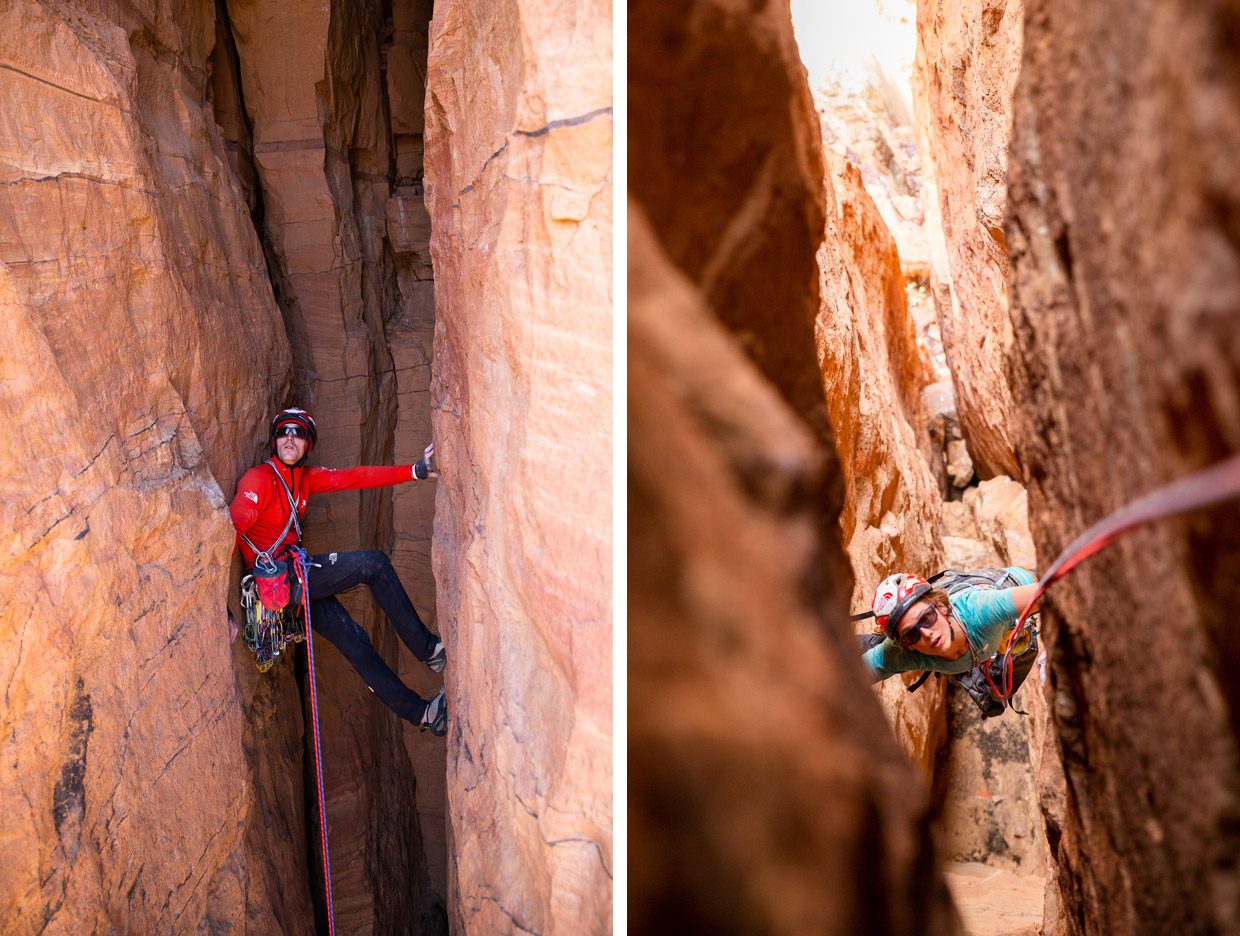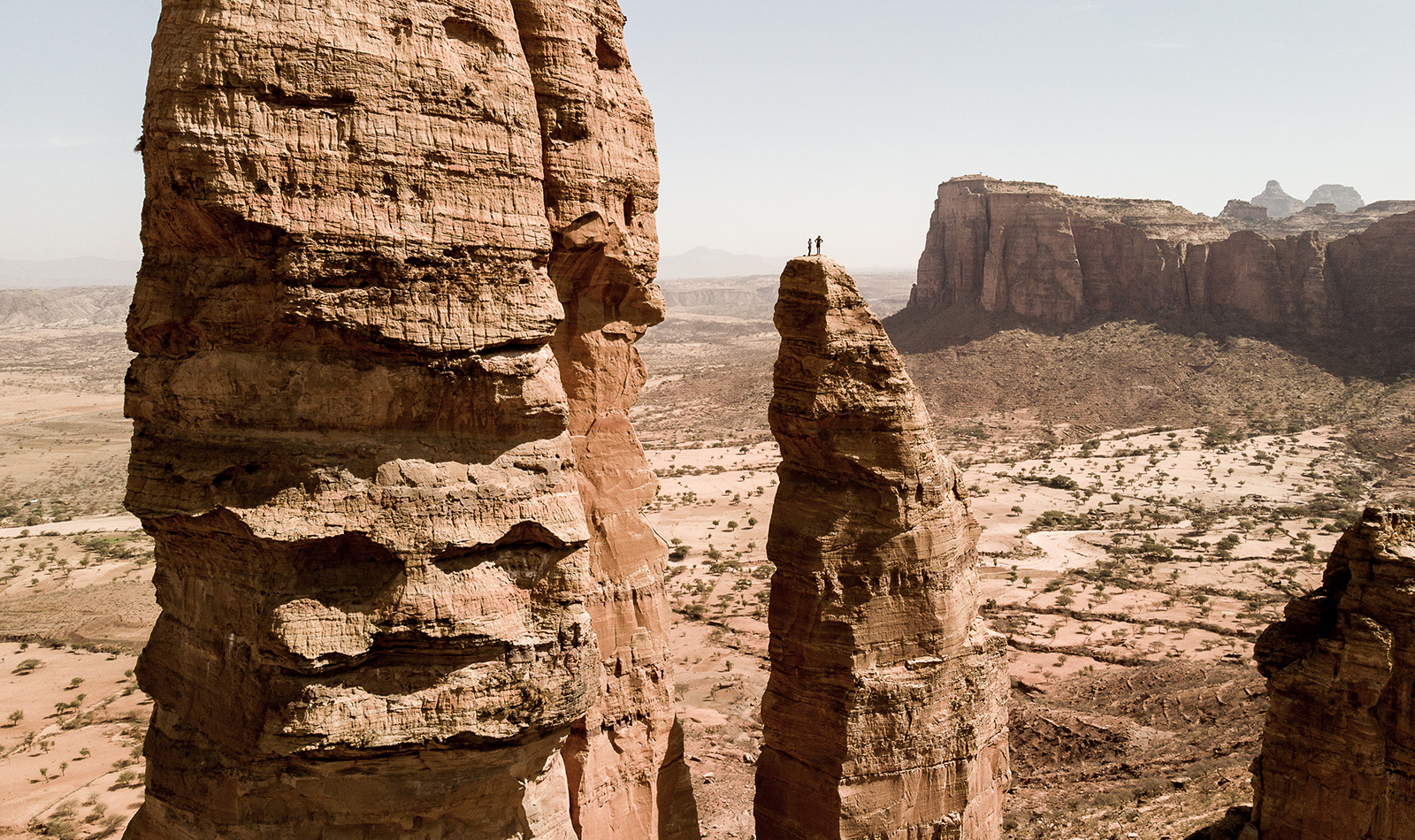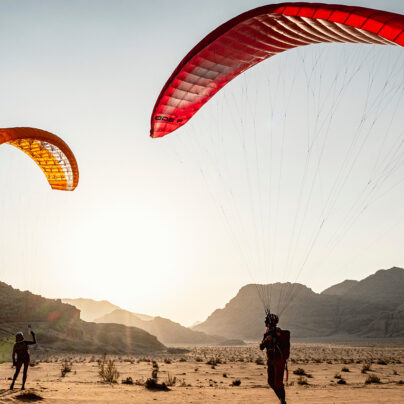Towers of Tigray
James Pearson // Presented by The North Face
‘ROCK!’
One word is all I can say, the only hope I have and only warning I can give. It seems unlikely that the paperback-sized stone will fall exactly where Caro hangs 20m below – after all, we’d taken special care to offset our belays from the climbing fall line as much as possible, and I’d traversed more than just a few metres during the last pitch. But had I drifted slowly back? That last overhang is surely big enough to see anything fly right over her head, even if it is laterally quite close. Right?
Time slows in moments like this, and all I can do is wait for a sound, any sound, hoping it’s a good one. It was such a careless mistake, but one that could happen at any time. It wasn’t a hold breaking under too much weight. I could accept something like that – an understandable risk in the sometimes dangerous game we play– but no, the culprit this time was a rogue cam, swinging from my harness, that clipped a loose flake just sitting on a ledge. Nothing and everything at the same time.
THUD!
Shit. That was quick; no way did that have time to fall to the floor. Even worse, that awful, dead sound was not rock on stone. It had hit something soft. I stand there utterly frozen, temporarily unable to ask the simple words.
‘WOW! That was close!’ Caro calls. I breathe again. ‘Are you OK? I am so sorry!’
‘Yeah, I’m fine… It hit the backpack!’
I struggle to process the words. What do you even say when something comes so close to total disaster, but is ultimately OK? One moment ago my entire life could have irrevocably and painfully changed forever, but now things are just carrying on as normal. ‘OK, cool. Just be careful!’


Caro and I have recently been climbing the amazing desert towers in the Tigray region of Ethiopia, and that incident took place on the penultimate belay of our new route, Excalibur, during the first ascent of one of the towers. This particular story gives me pause for reflection because it wasn’t the only close call we had on that route, not even counting all the sketchy lead climbing on loose holds with long run-outs. Caro broke off a fist-sized foothold at the top of the pitch below, and it hit my chalk bag as it plummeted to the ground, despite the fact that I’d squeezed myself flat against the wall.
On adventure climbs, loose rock is accepted as part of the package – and getting hit by something that might mean the end is a risk that anyone who goes climbing on this sort of route accepts. I’ve done countless sketchy routes all over the world. That risk has always seemed acceptable, mitigated by the caution and calculation I believe I bring. I always tell people that climbing is not about risk taking, but about risk management, and even if I know that something can always go wrong, the chances seem vanishingly small.
So why did this time feel different? The only casualty on that climb was a walkie-talkie stashed in the lid of the backpack, smashed into several irreparable pieces. We laughed, awkwardly, at how we’d try to avoid a third close call, then we switched the belay and headed on up the last pitch to the summit. The final pitch was perhaps the worst of the lot, a Gaudi-esque maze of wind-sculpted, bullet-hard patina, clinging to the wall by a delicate base of some of the softest sandstone around. The summit offered 360° views of the desert plains below, and we savoured Caro’s first ever real first ascent.
Caro has climbed all around the world and put up many beautiful new routes, but never had she made the first ascent of a true tower. What makes towers so special is that there is no easy way to the top. Climbing as a way of getting from A to B is often a choice, rather than a necessity, yet on a tower the only way to the top – the only way for human eyes to see that tiny part of the world – is to climb it. We’d dreamed of making a first ascent like this, but such towers are rare gems for climbers, and most have already been climbed.
By the time we finished enjoying our view of this beautiful part of the world, and made the multiple rappels back to the floor, we’d forgotten all about nearly caving our skulls in. It was all smiles for another amazing climb well done, and we gleefully strolled back down to the village below, to be greeted by the smiling faces and warm hugs of our parents and our little baby boy, who had been patiently watching all the action unfold from below.



This trip was our first attempt at real adventure climbing since Arthur was born just over one year ago. Arthur is a wonderful little bundle of joy, with chubby cheeks and a near-permanent smile on his face. He’s a real 4×4 baby, too, happy playing just about anywhere. Over the last year we’ve slowly been figuring out exactly what we can and can’t do with a baby. We came to Ethiopia for the location, the people, the culture, and the experience – to open Arthur’s eyes to a world far away from his own, and also to show other parents that adventure travel with a baby is not just possible, but a fun, rich, fulfilling experience. But how much, if at all, would we have to change our lifestyle to accommodate Arthur’s needs?
Bouldering – no problem! It’s easy to enjoy bouldering with a baby, and both Caro and I are now bouldering harder than ever before. Sport climbing? That’s OK, too. It’s a little more complicated than bouldering, and making redpoints of hard routes depends on luck in timing Arthur’s snooze just right, but a regular day having fun at the crag is certainly on. Single-pitch trad climbing? As long as the crag is comfy for Arthur, and the routes are short, then trad just about works. You can’t target anything bold or dangerous, as you never know when your belayer might ask you ‘Are you OK to hang around for a few minutes while I change a nappy?’, but well-protected clip-ups are little different from sport climbs.
Multi-pitch climbing is where things become more complicated. But despite my optimistic ideas about climbing easy routes with him on my back, the reality is that it’s just asking too much. If you want to continue climbing multi-pitch routes as a parent, then you’d better find a new third-wheel climbing partner and take it in turns to climb, or, like we do, bring along a babysitter. And that’s precisely how we found ourselves in Ethiopia, with my mum and Caro’s dad.
It seemed like the perfect solution, and for the most part it was. They love spending time with their grandson, and at the same time they get to visit an amazing part of the world that they would probably never otherwise have seen, and we get to go off every few days and climb something special. Win win!
I always wondered what effect becoming a father would have on my climbing. Though I don’t consider myself to be reckless – far from it, actually – I can’t argue that risk and danger are not integral parts of my preferred climbing style. I expected some dramatic revelation the first time I looked into Arthur’s eyes, but to be honest it never came. I can’t say that having a child has changed my climbing behaviour in any noticeable way. Writing those last sentences shocks me. It makes me sound like a selfish asshole, and to a degree that might actually be the case, but this is just another extension of how I process risk.
All through my climbing life I’ve weighed up the pros and cons of doing dangerous routes. What is the consequence of falling and what is the chance of falling? How good does the gear seem and how fit do I feel? Is this route really worth me potentially breaking my legs this weekend, or would I prefer to go on holiday bouldering with my friends? It’s never quite as simple as this, and most of the time there’s a whirlwind of confusing things all being processed without me consciously realising it, but I honestly believe that Arthur is now another part of this subconscious calculation process. Since I’ve become a father, a route would have to be something truly special for me to justify taking even a minor risk to my safety, and ergo his happiness.



If my attitude has changed, then it has been a gradual change, perhaps partially a result of getting older and wiser. I don’t feel like I’m doing anything reckless with Arthur, but I’m certain you could find many people who disagree. But we can justify almost anything to ourselves. Nobody would be happy thinking they were a monster, and so we find ways to convince ourselves otherwise. We all live in our own little bubbles and are constantly reinforcing our own worldview – until, that is, you come down from a sketchy climb with two severe near-misses, and stand face to face with all the people you love the most. In that moment it’s hard to justify that you made the right calls, and the idea lurks that regardless of how epic the tower was, and how amazing the first ascent felt, you’re a selfish asshole.
What of the future? I’ve grown up with adventure as a major part of my life and it seems only natural to share this with Arthur. At the same time, I know that this way of looking at the world is skewed, and I don’t want to force this life on him – rather, I want to give him the chance to choose for himself what he might one day want his life to be.
People often ask Caro and I if we’d be happy if Arthur were to become a climber one day. Climbing has brought us so many wonderful things in life: the chance to travel all over the world, to meet people and discover places we never would have otherwise, and most importantly focus and purpose. If Arthur ends up loving climbing, I’ll be really happy, but I’ll be just as happy if he loves running, or biking, or playing the violin, or flower arranging. My goal as a father is to show him that he can go anywhere and do anything, and if I manage to show him that, I’ll feel like I’ve done a pretty good job.
Follow James Pearson and Caroline Ciavaldini’s adventures on Instagram https://www.instagram.com/onceuponaclimb/
Photography by Will Lascelles // Colab Creative // Olya Dendyaeva.
James and Caroline are supported by The North Face
Instagram: @TheNorthFaceUK
Facebook: /thenorthface




